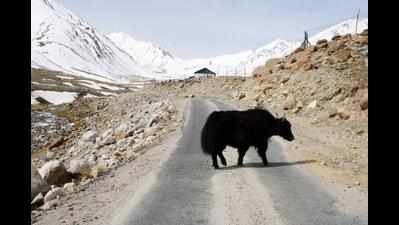- News
- City News
- guwahati News
- Yak deaths decrease in Arunachal Pradesh
Trending
This story is from November 22, 2016
Yak deaths decrease in Arunachal Pradesh
Scientists of the National Research Centre on Yak (NRCY) at Dirang in Arunachal Pradesh say that in the last three years they have been able to bring down yak deaths caused by the parasitic Babesiosis disease by 90%.The NRCY is the country's only research facility on yaks.

GUWAHATI: Scientists of the National Research Centre on Yak (NRCY) at Dirang in Arunachal Pradesh say that in the last three years they have been able to bring down yak deaths caused by the parasitic Babesiosis disease by 90%.
The NRCY is the country's only research facility on yaks.
Senior scientist Pranab Jyoti Das said Babesiosis used to be the major cause of death for yaks. The domesticated animal is the main source of livelihood for hundreds of herders, traditionally known as Brokpas.
"Due to scientific intervention, production of yaks has increased by 10 to 15% in the last five to 10 years.Farmers are gradually accepting scientific methods in yak husbandry," said Das.
According to the scientists, the Brokpas are increasingly giving up their traditional nomadic way of rearing yaks in favour of the sedentary way.
Earlier, Brokpas had to move from one place to another across the mountains in search of grazing for the yaks. During winter, Brokpas and their yaks would come down to lower heights to escape the freezing cold.
Scientific mediation in rearing techniques has not only increased the yak population from 9000-odd in 2003 to over 14,000 now, it has also convinced the Brokpas that they can rear animals without having to constantly move from one place to another.
This year, the NRCY in association with the Army and the Indo-Tibetan Border Police brought together 500 farmers – including 300 yak farmers – at the Yak Mela at Lubrang, a village located about 10,000 feet above sea level in the West Kameng district of Arunachal.
The mela is organized every year to encourage yak farmers to adopt more scientific methods of rearing their livestock and expose them to new technologies in animal husbandry.
NRCY director SM Deb was also present at the mela. More than 1,000 yaks were brought to the annual competitions for best milk-producing yak, best yak bull, the Brokpa with the most number of yaks, and the best ethnic item exhibition stall.
End of Article
FOLLOW US ON SOCIAL MEDIA










